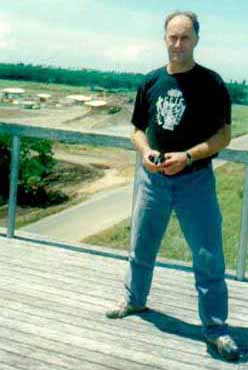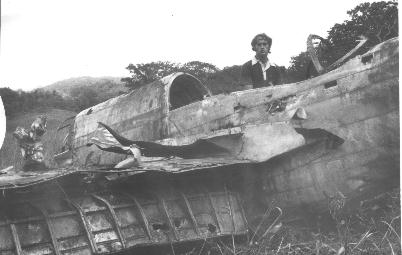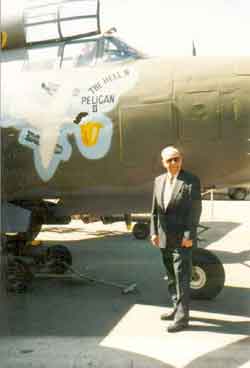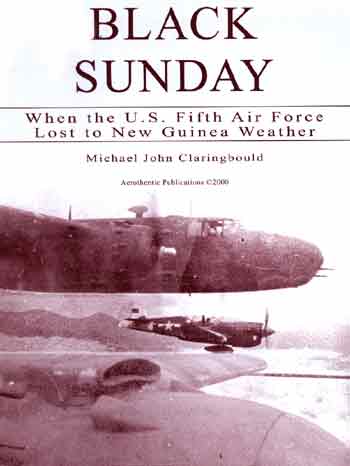What Was The First Wreck You Visited?
 I attended early school
in Papua New Guinea. We were taught history which of course was Eurocentric.
When it came to WWII I remember how things like Dunkirk, Churchill,
Battle for Britain etc were emphasized. On the other hill from the school
was an aircraft wreck. I remember asking all the teachers, "there was
war here, why aren't you teaching us about that, and how did the aircraft
on the other side of the hill crash ?". The teachers could not answer
either question. This question suddenly
struck me, because it hit me with the realization that the first aircraft
wreck I visited was one of the hardest to identify. It is the wreck referred to in Port Moresby in the first question, and pieces of it still lie on the hill on the other side of my
former Primary School, then named Boroko East, now part of Port Moresby
International.
I attended early school
in Papua New Guinea. We were taught history which of course was Eurocentric.
When it came to WWII I remember how things like Dunkirk, Churchill,
Battle for Britain etc were emphasized. On the other hill from the school
was an aircraft wreck. I remember asking all the teachers, "there was
war here, why aren't you teaching us about that, and how did the aircraft
on the other side of the hill crash ?". The teachers could not answer
either question. This question suddenly
struck me, because it hit me with the realization that the first aircraft
wreck I visited was one of the hardest to identify. It is the wreck referred to in Port Moresby in the first question, and pieces of it still lie on the hill on the other side of my
former Primary School, then named Boroko East, now part of Port Moresby
International.
 In grade 6 three of us carried the
other wing tip back to my backyard. From photos I took in those
days I know that the wreck is that of a P-40E. Years later, I confirmed it to be P-40E Kittyhawk A29-109 used by the RAAF in the early defense of Port
Moresby. There are vast numbers of USAAC aircraft
lost in New Guinea for which there are no records. This normally
occurred whereby no crew were lost in the incident. Furthermore, no-one in the whole of Port Moresby
had answers to the crashed aircraft either. I became seized with
the idea of finding the truth. That has stayed with me ever since. I've visited sites all across
the Pacific, including Fiji where, believe it or not lies the
wreck of P-39D Airacobra 41-7104 in the jungles of Viti Levu!
In grade 6 three of us carried the
other wing tip back to my backyard. From photos I took in those
days I know that the wreck is that of a P-40E. Years later, I confirmed it to be P-40E Kittyhawk A29-109 used by the RAAF in the early defense of Port
Moresby. There are vast numbers of USAAC aircraft
lost in New Guinea for which there are no records. This normally
occurred whereby no crew were lost in the incident. Furthermore, no-one in the whole of Port Moresby
had answers to the crashed aircraft either. I became seized with
the idea of finding the truth. That has stayed with me ever since. I've visited sites all across
the Pacific, including Fiji where, believe it or not lies the
wreck of P-39D Airacobra 41-7104 in the jungles of Viti Levu!
Views About The Sanctity of Wrecks?
 I
used to think they should be left alone. Then I changed my mind. After recovering
A-2G "Hell'N Pelican" 42-86786 I changed it back again and wished we'd never lifted it from
the jungle. Now I'm happy that we did. I'm afraid this is an emotive subject on
which there are differing and passionate views, and most of which have a sound
basis, even differing views. It is also a political matter.
I
used to think they should be left alone. Then I changed my mind. After recovering
A-2G "Hell'N Pelican" 42-86786 I changed it back again and wished we'd never lifted it from
the jungle. Now I'm happy that we did. I'm afraid this is an emotive subject on
which there are differing and passionate views, and most of which have a sound
basis, even differing views. It is also a political matter.
Salvage of aircraft
from the Pacific environment is the most difficult thing I've ever done. It is
never easy. It is always expensive. The key word however is RISK. We were lucky
to salvage The Hell'N Pelican in 1984. We came close to losing the entire ship,
not to mention some of the team. Good question Justin, but you probably don't
have enough space on your server for me to let fly on this issue! As to restoration,
just one word - expensive.
Advice For Searching For Missing In Action (MIA) Aircraft
 This is a difficult question. The area is so esoteric,
and very much misunderstood. The MACR is only the first calling
card, for American USAAF wrecks. Once you obtain that you need an understanding of the unit
involved, what was going on around at the time, the circumstances
of loss etc etc. In some cases the site was discovered just post-war,
but not reported. My recommendation is to contact me in the first
place and I can at least put them in the right direction. I hasten
to add that despite the enormity of my data bases, there are often
cases with which I can offer no assistance at all. Paperwork in
those days was not a strength of the units concerned. The reality
is that they were more concerned with fighting a hostile enemy in
a hostile environment.
This is a difficult question. The area is so esoteric,
and very much misunderstood. The MACR is only the first calling
card, for American USAAF wrecks. Once you obtain that you need an understanding of the unit
involved, what was going on around at the time, the circumstances
of loss etc etc. In some cases the site was discovered just post-war,
but not reported. My recommendation is to contact me in the first
place and I can at least put them in the right direction. I hasten
to add that despite the enormity of my data bases, there are often
cases with which I can offer no assistance at all. Paperwork in
those days was not a strength of the units concerned. The reality
is that they were more concerned with fighting a hostile enemy in
a hostile environment.
I regret that the US government
could do more to recover its lost airmen. I want to make it clear from
the start that I regard the US military organization primarily responsible
for this action: US Army CILHI / JPAC in Hawaii - to be completely professional. Put
simply however, they could do with more funding. They are being asked
to do an impossible job with a limited budget.
Some relatives are impatient
with their perceived slowness, but I'm more than impressed with what
they are achieving with what they've got. Their Director Johhnie Webb
commands fine recovery teams, but at the same time shoulders a vast
burden of responsibility towards the safety of these teams. And, in
addition to WW2 they are reclaiming remains from North Korea, Vietnam and everywhere else. I regularly consult with them, and them with
me. Their field trips must high standards, and they do just this. I
think what impressed me most when I visited them recently was their
high morale and motivation. Fine people.
 Discovery of Guadalcanal Wildcat
Discovery of Guadalcanal Wildcat
In 1998, I discovered the wreck of one of the US Navy's most famous aircraft
wrecks: the first American aircraft shot down during the Guadalcanal
campaign on 7th August 1942: F4F Wildcat 5192.
Two weeks
after the discovery, Saburo Sakai the Japanese pilot who had shot down the aircraft, Japanese ace Saburo Sakai, was presented with a small piece of the aircraft
as a souvenir. Read
an excerpt from Saburo Sakai's
autobiography, about this dogfight. You Justin, are the only other person who I have told about the site. I wanted you to visit it so it could be properly documented by Pacific Ghosts.
Tell About Writing Your Books
 Black Sunday took eight years of research, although books take me less now as
I have refined the process. They are still highly demanding. In a nutshell once
the concept for a book is there I draw on veterans diaries (and recollections
- with great care), official records and the plethora of contacts I now use world-wide.
My sources are the best in the world. This is no boast. The numbers of those on
the planet with serious interests in the aerial Pacific war are limited. We all
know each other, and it's a small world.
Black Sunday took eight years of research, although books take me less now as
I have refined the process. They are still highly demanding. In a nutshell once
the concept for a book is there I draw on veterans diaries (and recollections
- with great care), official records and the plethora of contacts I now use world-wide.
My sources are the best in the world. This is no boast. The numbers of those on
the planet with serious interests in the aerial Pacific war are limited. We all
know each other, and it's a small world.
 If I have an unanswered query
or need to clear up a point I consult the world expert. For example, for a B-25
technicality I contact historian Bob Haney, for one on a Japanese air unit, author Henry Sakaida. For official records,
the folks at US Army CILHI. I should add that sometimes
we are in disagreement over a point. There is no animus in such cases. We each
state a viewpoint, sift the evidence, and publish what we think is best. If I
am unclear on a point in my books, I will say so. This is considered a risky policy
by larger publishing houses, but Aerothentic considers it a necessity.
If I have an unanswered query
or need to clear up a point I consult the world expert. For example, for a B-25
technicality I contact historian Bob Haney, for one on a Japanese air unit, author Henry Sakaida. For official records,
the folks at US Army CILHI. I should add that sometimes
we are in disagreement over a point. There is no animus in such cases. We each
state a viewpoint, sift the evidence, and publish what we think is best. If I
am unclear on a point in my books, I will say so. This is considered a risky policy
by larger publishing houses, but Aerothentic considers it a necessity.
For example, I am still in disagreement with authority John Stanaway over the date of a certain P-38 loss. John however has a diary extract which proves
his point. I have no prime source documentary evidence for my case and still think
I'm right, but time will tell. John is a classic example of my world-wide contacts.
We've never met, but have exchanged occasional correspondence for the last ten
years or so.
As with any
publishing, there is always a compromise between expediency and
historical accuracy. I operate Aerothentic
Publications 'history for history's sake'. I have turned down offers from
five major US publishing firms to write for them simply because
I don't have the time. Aerothentic is about interesting and accurate
history. That takes time, and lots of it. Now, the books are available via Pacific Ghosts.
Any Regrets Or Future Aspirations?
 First, that history has lost the true flavor
of the Japanese side of the air war. Most of the units were decimated,
and so almost no veterans survive. Saburo Sakai is an example, but he
is also a huge exception. Sakai was Navy however, and the Japanese army
units were more badly decimated than their Navy counterparts. There
are many intact Japanese aircraft in the Pacific. I have argued with
many on this, but I maintain that in most cases our knowledge of their
history will only ever be superficial.
First, that history has lost the true flavor
of the Japanese side of the air war. Most of the units were decimated,
and so almost no veterans survive. Saburo Sakai is an example, but he
is also a huge exception. Sakai was Navy however, and the Japanese army
units were more badly decimated than their Navy counterparts. There
are many intact Japanese aircraft in the Pacific. I have argued with
many on this, but I maintain that in most cases our knowledge of their
history will only ever be superficial.
Second, that so little of worth has been
written on the Pacific air war due to the Eurocentric focus of US WW2
history. The men who fought there deserve better. There is another factor
which is slightly more subtle. I constantly come across veterans who
will tell me that this is the first time they have discussed their war
with anybody. I know that there are many ETO vets in the same boat,
but I genuinely believe that the unusually harsh conditions of the Pacific
lent themselves to a post-war era in which the Pacific veterans kept
to themselves more than their European counterparts because of what
they had been through. Tome (and I'll get shot for saying this) the
ETO was mostly aerial trench warfare in the skies. The Pacific theatre
was anything but . . .
One aspiration: That one day clear recognition will be given to the efforts
and sacrifices made by all in the Pacific war.
Thank you for the interview, Mr. Claringbould!
References
Aerothentic Publications by
Michael Claringbould
First Japanese Mission To Guadalcanal August 7, 1942 (1998) by Michael Claringbould
Eagles of the Southern Sky (2012) by Luca Ruffato, Michael Claringbould and associate editors







